The ADATA XPG GAMMIX S10 (512GB) SSD Review: Entry-Level NVMe With Style
by Billy Tallis on October 25, 2017 8:30 AM ESTAnandTech Storage Bench - Heavy
Our Heavy storage benchmark is proportionally more write-heavy than The Destroyer, but much shorter overall. The total writes in the Heavy test aren't enough to fill the drive, so performance never drops down to steady state. This test is far more representative of a power user's day to day usage, and is heavily influenced by the drive's peak performance. The Heavy workload test details can be found here. This test is run twice, once on a freshly erased drive and once after filling the drive with sequential writes.
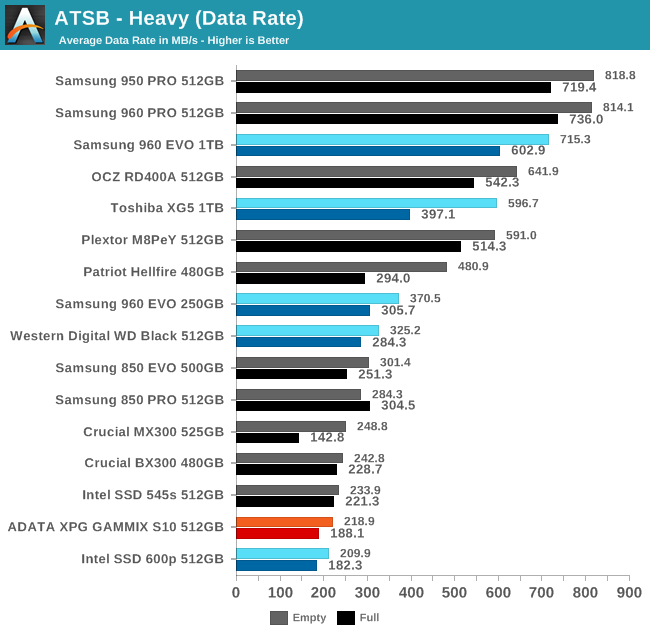
The ADATA XPG GAMMIX S10 doesn't handle the Heavy test much better than the Intel 600p did. Both deliver a lower average data rate than many SATA SSDs.
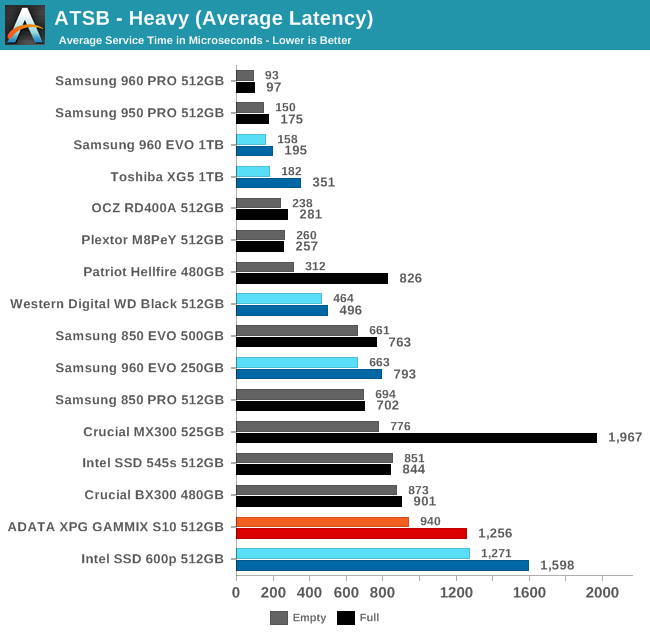

Both the average and 99th percentile latency scores of the GAMMIX S10 on the Heavy test are a clear improvement over the Intel 600p, but both drives are behind mainstream SATA drives and even further behind the TLC NVMe competition.
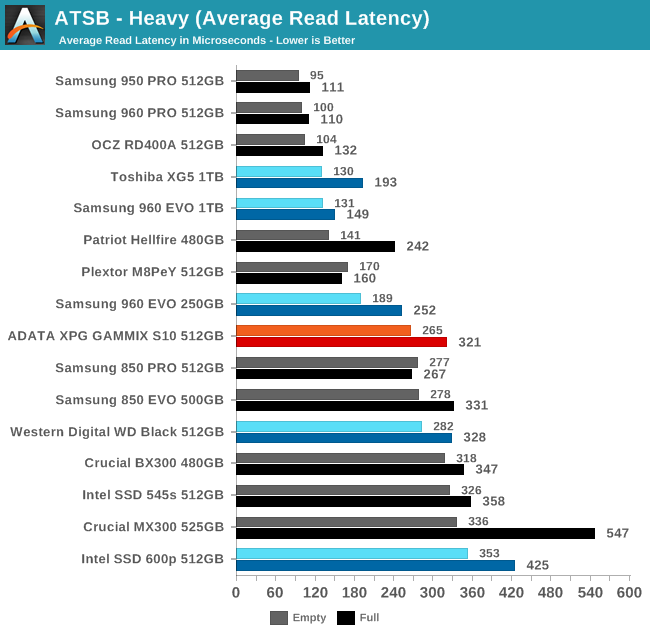
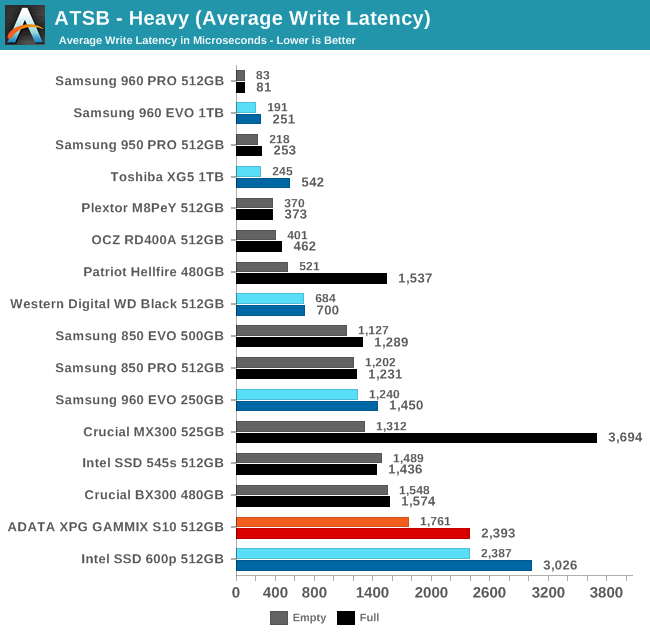
The average read latency of the GAMMIX S10 is slightly better than most SATA SSDs, but substantially higher than the typical NVMe SSD. The average write latency is more of a problem, as it is generally higher than mainstream SATA SSDs.

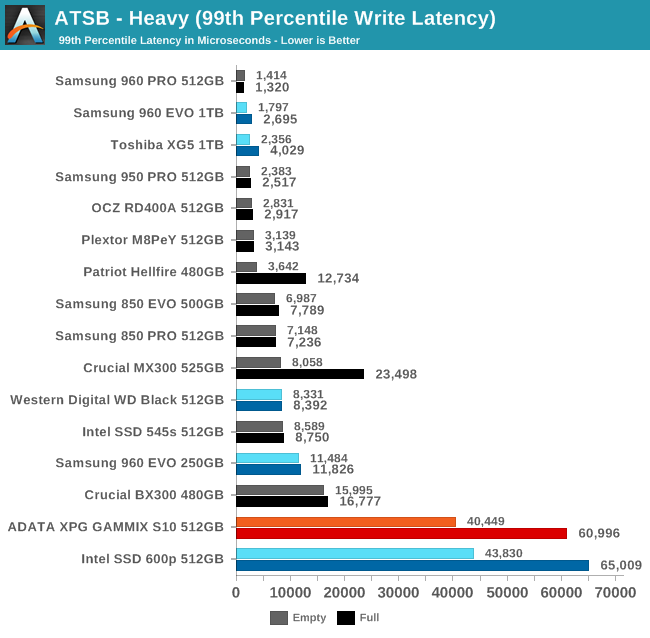
The 99th percentile read latency of the GAMMIX S10 is good, beating some MLC-based NVMe SSDs and any SATA SSD. The 99th percentile write latency is only slightly better than the Intel 600p, and both have a serious problem with controlling write latency.
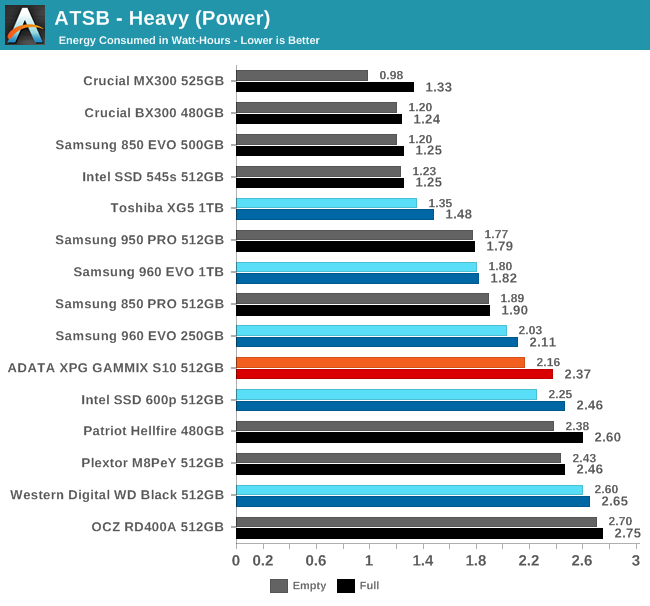
The power consumption of the GAMMIX S10 on the Heavy test is typical for most NVMe SSDs. Good SATA SSDs use much less energy over the course of the test, but few current NVMe SSDs can match the efficiency of SATA, and the GAMMIX S10 isn't one of them.










27 Comments
View All Comments
futrtrubl - Wednesday, October 25, 2017 - link
Disappointing.jabber - Wednesday, October 25, 2017 - link
Why? You wouldn't notice if it could do 3500MBps either.futrtrubl - Thursday, October 26, 2017 - link
Because it does less but costs more. What isn't disappointing about that?jabber - Thursday, October 26, 2017 - link
Yeah but it looks much fancier so to the average Joe that's worth another $30! It's a strategy that Apple has used and been praised for for decades. Performance means nothing to the computing masses. It's just those of us on IT forums that care.FullmetalTitan - Thursday, October 26, 2017 - link
No "average Joe" is even looking at NVMe SSDs.This costs double the price of a GOOD SATA SSD, and frequently fails to even meet that performance level.
jabber - Thursday, October 26, 2017 - link
You'd be amazed at what I see 'Average Joe's buy. Shocking at times."Why did you buy...that?"
ddriver - Wednesday, October 25, 2017 - link
That's some pristine engineering idiocy right there, having the heatsink make contact with only a small part of the chip area deliberately.ddriver - Wednesday, October 25, 2017 - link
"GAMMIX" - more like "gimmix" LOLrrinker - Wednesday, October 25, 2017 - link
I saw that skipped right to the conclusion for the (predicted) disappointing results. If they screw up the engineering for the sake of appearance like that, I was sure the rest of it would be disappointing as well.ddriver - Wednesday, October 25, 2017 - link
The thing is that the heatsink is protruding between the adhesive pads, so it presumably makes contact with the chip, however without any thermal interface material it is likely that the heatsink severs to insulate and worsen thermal performance than to improve it.Probably it is a mix of both, yielding somewhere between barely improving to barely "detrimenting" thermal performance, making it mostly a pointless gimmick.
Like everyone else, ADATA is well aware how low average consumer IQ is, thus attempting to make this fly.
On the bright side of things, adding some thermal paste would easily make the cooling solution functional. Although I doubt the product performance will get any less pathetic because of that. They didn't put that heatsink there because it is throttling as a side-effect of being very fast. They put it as a cosmetic feature, that much is evident from the clumsy implementation.